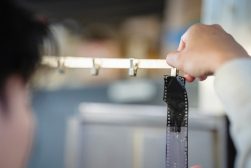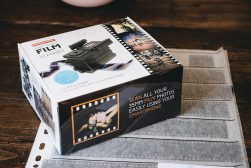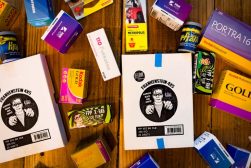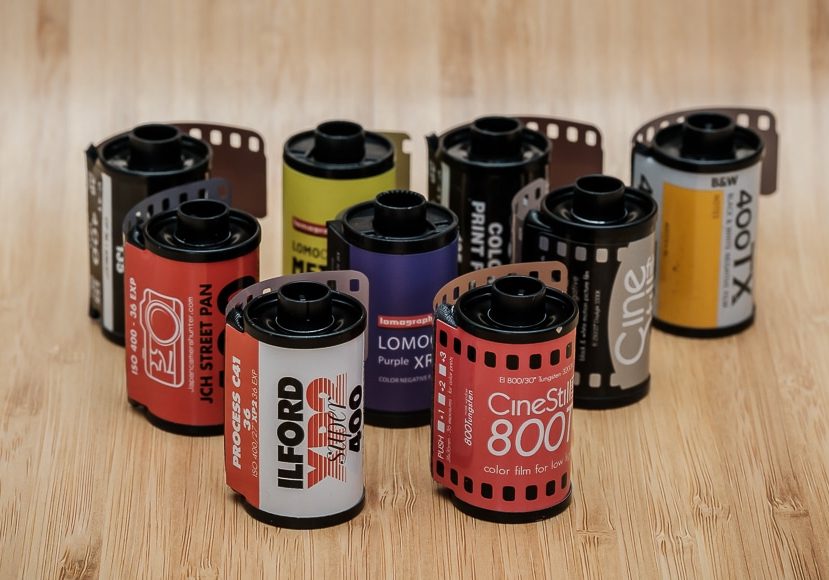
Guide to Camera Film Stock: Types, Developing, Examples
Taking up film (analogue) photography? This guide to film stock will teach you everything you need to know: what film to buy, how to use and print it, and more!
Film Photography | Learn | By Greg Cromie
I don’t know if you’ve noticed, but film photography is making a huge comeback! If you’re considering taking up film photography, this article’s for you.
Film photography and film cameras in general are once again enjoying a Renaissance, and this time it’s not just the inner city hipsters who are leading the charge.
To make the most of your experience in film photography, you’ll need a little information to get started and make the right film choices.
While the range of film stock is not as great as it used to be, there’s plenty available and many new variants making an appearance.
This article will cover the most common film stock types, film characteristics and explain the processing and scanning process.
We’ll provide our top picks of film stocks for general purpose and cover a few special-purpose options for you to consider if you’re feeling confident with film photography.
To help you in this exciting endeavour, we’ve answered the most common questions about film stock too.
Let’s get the ball rolling.
What are the Film Stock Types?
C-41 Colour Negative Film
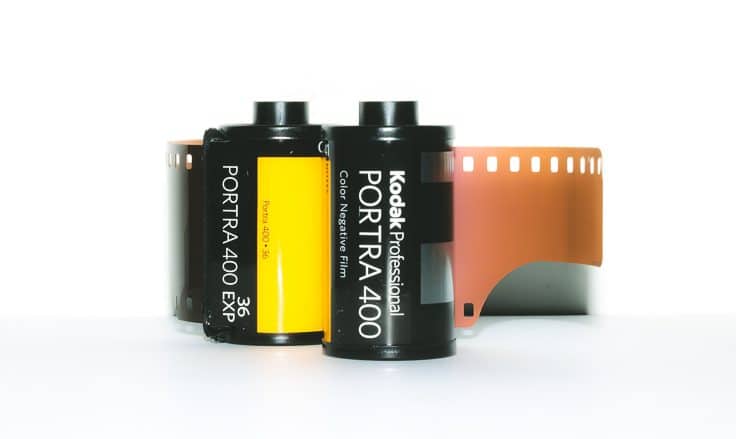
A lot of film stock has come and gone over the decades.
C-41 has proven to be the most popular survivor of the lot. The stock is named C-41 for its intended use at 41-degrees Celcius – that’s Aussie summer hot!
C-41 films use a developing process built into more affordable processing machines used by camera retailers and pharmacists. Kodak created the C-41 film stock type – other film manufacturers had different names, but the collective is known as C-41 film.
The film is available in various formats, with the most popular being 35mm and 120. It’s a colour negative film that captures images in a negative or reversed colour and tone.
Once developed, the film negative is printed or scanned, the projected light switches the negative to create a positive photo.
Kodak has been in the film photography game since 1892 – they know a thing or two about film!
Kodak Portra is a popular colour negative film stock. It’s excellent for daylight and indoor low light conditions. It’s also available in 160 and 800 film speeds to suit different lighting conditions.
What’s more, Portra is available in both 35mm and 125 roll – it’s also available in large format sheets.
Kodak’s Portra 400 characteristics are balanced colour saturation, forgiving outcomes, and a super fine grain if you get the exposure right. If you’re looking for a colour film for portraiture, Portra is the one.
Like Kodak, Fujifilm in Japan has manufactured film stock for a long time – since 1934.
Fujifilm Superia X-Tra 400 is a brilliant stock proven to be a popular choice for those looking for an everyday option.
The 400-speed film is suitable for daylight and indoor shooting conditions and provides a perfect colour balance and saturation. Photographers love Fujifilm for its history and success with colour science.
Superia X-Tra 400 is only available in 35mm film stock. The finished images provide a great dynamic range of bright and shadow areas, plus the grain is on the coarse side.
Like Kodak’s Portra, it’s ideal for portraiture due to the strong Fujifilm colour science.
The battle of the entry-level film stock is between Kodak Gold 200 and Fujifilm FujiColour 200.
How Much Do You REALLY Know About Photography?! 🤔
Test your photography knowledge with this quick quiz!
See how much you really know about photography...

Both films suit everyday happy snaps where people are not looking for superb image quality or colour reproduction.
That’s not to say that both the Kodak and Fujifilm stock are no good – they’re just for general purpose family and holiday shots.
Kodak Gold 200 is a highly affordable 35mm film that produces medium results in colour saturation, dynamic range and grain. The Fujifilm Fujicolor 200 offers almost identical specs, with neither performing very well in low light.
Here’s the cheapest place to get film developed.
E-6 Colour Reversal (Slide Film)
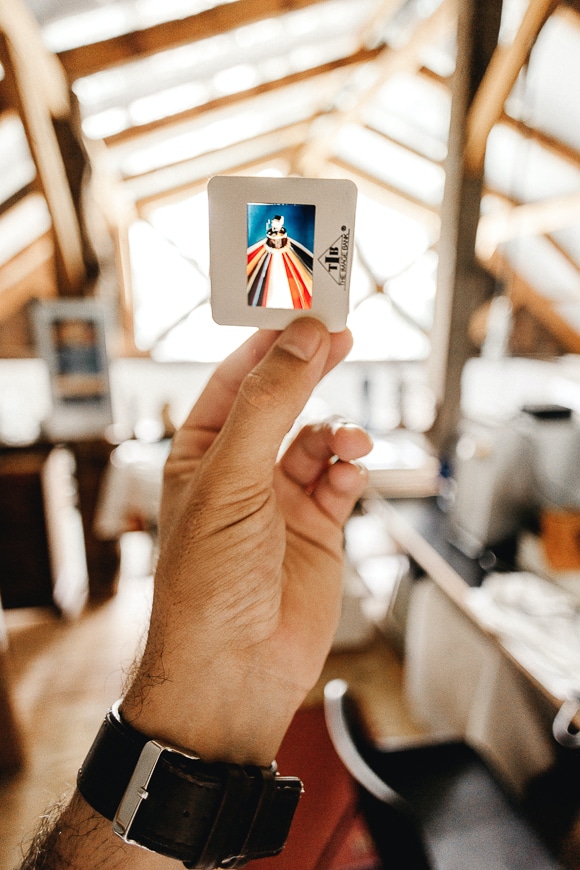
E-6 film stock is a dying breed as it’s less popular and more expensive to purchase and develop.
It’s more commonly known as colour reversal or slide film stock – slides are the individual frames from the film mounted in a white slide border for easy viewing.
E-6 works oppositely to C-41 – once processed, it displays a positive image on the film rather than showing a negative. Despite its demise, slide film is very user friendly as images are viewed on a slide or via a projector.
Slide film is also known for excellent image resolution and sharpness.
The photo lab at your local camera store may not process E-6 film – you’ll have to hunt around for a suitable lab. There are plenty of online services where you can mail in your film.
Kodak Ektachrome is a slide film available in 35mm and 120.
Its low speed means Ektachrome 100 is ideal for good lighting conditions, or the results will be muddy at best. E100 delivers exceptional colour saturation that makes images pop with vibrance and life.
The film produces a super fine grain that’s barely visible with optimal exposure. What’s more, if you shoot landscapes or portraits, the right lighting conditions provide significant variance in tonal values.
Being a slide film, if projected on a larger scale, the resolution is stunning – bring back slide nights!
Fujifilm’s Velvia 100 is a slide film that calls upon Fuji’s history with colour to deliver stunning saturation.
It’s available in the usual 35mm format plus 120, 4×5 and 8×10 sheets.
You should only shoot with Velvia in broad daylight due to its 100 speed and unforgiving exposure behaviour. If you get the lighting right, the film will produce optically sharp and vibrant images making it well suited to wildlife photography.
The grain is fine and sharp but barely noticeable due to the vibrance of colours.
Velvia is also a very popular film simulation used for JPEGs produced by Fujifilm digital cameras.
Black and White Film
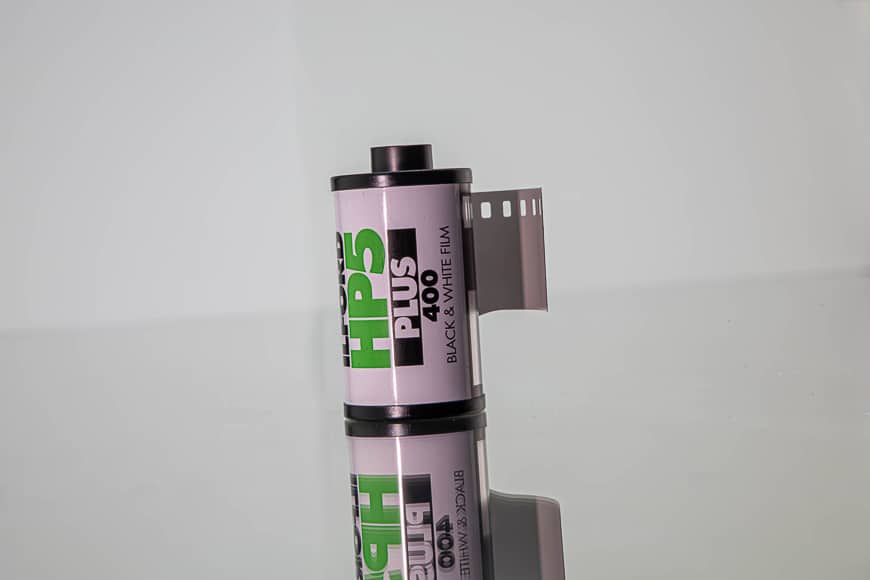
My favourite film stock is a black and white film – add a little grain and contrast, and you have a winner.
Some black and white films use the C-41 process, and others use a more traditional method. The conventional way is more straightforward, and many people choose to develop black and white film at home.
The beauty of a black and white film comes from its contrast to pull together a powerful composition. B&W film is also a lot easier to develop at home than colour film.
If you’re a fan of the grittiness of black and white photography, make sure you give one of these film stocks a spin.
Ilford’s HP or Hypersensitive Panchromatic series of film began production in 1931, with the latest version being the Ilford HP5 Plus.
The 400-speed film is widely respected and available in 35mm, 120, 4×5 and 8×10 large formats.
HP5 Plus is a black and white film that delivers a medium level of contrast, nice tonal range with a gorgeous mid-level of grain. The best bit about this Ilford film stock is that thanks to its 400 speed, it’s used in a range of genres.
Landscape, portrait and wedding photographers will love the flexibility of this film.
Ilford’s HP5 Plus has a little competition in the form of Kodak’s Tri-X 400 – I remember shooting with Tri-X in art school 200 years ago!
Tri-X 400 is another film that’s ideal for indoor and outdoor shooting conditions and is incredibly flexible even in lower light.
It’s existed since 1954 and hasn’t altered from the strong contrast, punchy tones and coarse grain to make it popular in the photography community.
As with the HP5, use the Kodak Tri-X 400 in various genres, especially if you want a lot more punch and contrast to your images.
Ilford Delta 3200 is a rare breed of black and white film stock thanks to its ultra-high-speed rating.
Delta 3200 is available in 35mm and 120 and is the best black and white film for dark conditions.
It delivers a well-balanced contrast level but amplifies the grain to create moody, textured images with the correct exposure.
If you want to shoot dark and moody portraits, Ilford Delta 3200 will not disappoint.
New Film Stocks on the Block
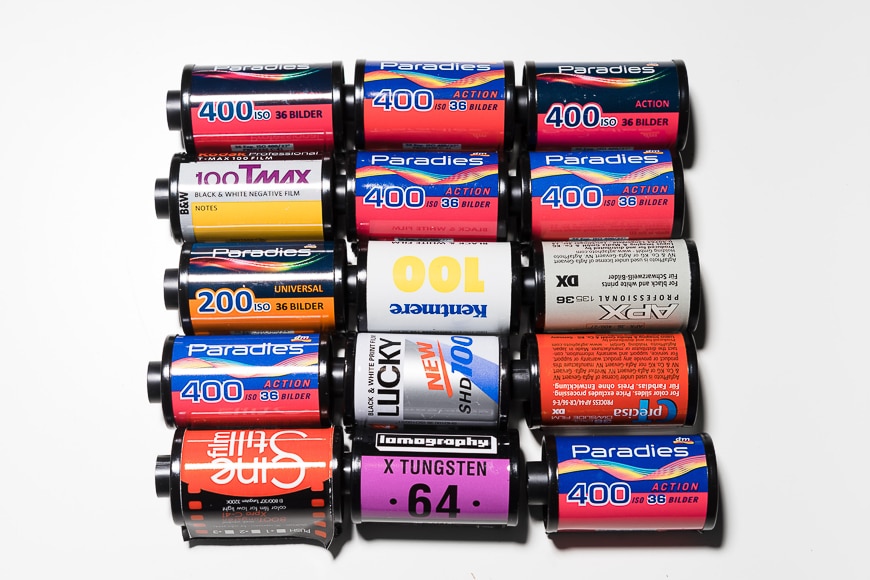
While companies like Kodak, Ilford, and Fujifilm have a long and successful history creating film stock, many new film stock are appearing in recent years.
As film enjoys yet another boom, more and more small outfits are making film stock. Some are developed from the ground up, while others are repurposing surplus film and cinema stock.
- CineStill – In operation since 2021, CineStill Film has quickly grown in popularity thanks to their CineStill 50D and 800T. CineStill 50D is a colour negative film suitable for daylight conditions. 800T is a fast colour film derived from motion picture cinema film and is excellent for punchy street photography.
- Lomography – Lomography is known for creating unique and fascinating film stock. Among their growing range, Lomo 400, LomoChrome Purple, and Berlin Kino 400 deliver results like no other. All are available in 35mm and 120. See: What are the best lomography cameras?
- RetroChrome – RetroChrome was developed in 2015 by Film Photography Project. At an auction, they purchased a bulk lot of military surplus film stock. It turned out to be expired Kodak Ektachrome. The uniqueness of this film comes from its expiration date lapsing almost two decades ago. If you can find a roll of this 35mm film, you’re lucky.
What Are Film Characteristics?

I bet you didn’t know that film produces a higher level of resolution than an equivalent digital camera.
The larger the film format, the greater the resolution – the size of the film surface areas captures greater levels of resolution.
Let’s take a look at the two most critical elements of film stock.
Film Speed
Every film has a speed that determines how well the film will perform in different lighting conditions.
Typical film speeds range from ISO 100 up to around 400. Many have a higher range of 800 (CineStill 800T), and even 3200 (Ilford Delta 3200). Some film speeds drop as low as the Lomography Babylon 13 ISO & Fantome 8 ISO.
The higher the speed, the better the film handles low light conditions without impacting image resolution and detail.
Low-speed films should only operate in daylight conditions – trying to use them in low light can result in muddy, dark and grainy prints.
Film Grain
Film grain appears as minuscule grains or spots on a film photo.
Film grain is caused and defined by the microscopic particles of silver halide crystals that coat the surface of the film stock. These particles are light-sensitive to capture the variance in light, but they also leave granularity on the final images.
Photographers describe grain in varying degrees between fine and course. Camera settings such as aperture, shutter speed, and ISO affect the level of grain.
However, a camera’s ISO setting has the most significant effect on grain as the higher the ISO, the more noticeable the grain is.
In most cases, some level of grain is unavoidable – and that’s ok as grain adds a unique quality to film photos.
35mm, 120 and 4×5″ Explained
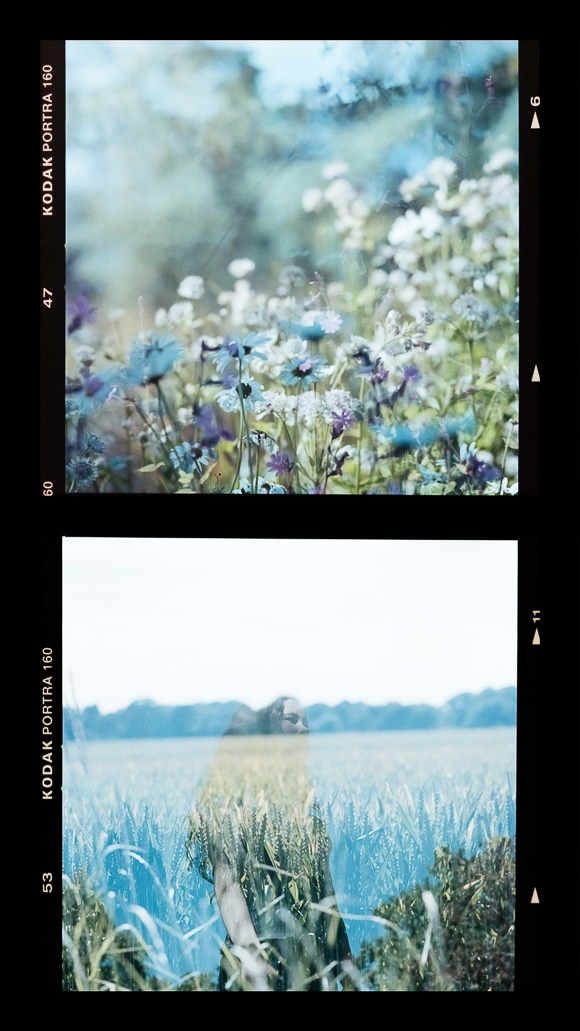
35mm (135)
Film stock is available in more sizes or formats than the typical 35mm roll found at a corner store.
35mm film, previously referred to as 135, is a standard film format with a 35mm (1.4″) gauge – the width of the physical plastic strip. The frame that the image is capture on is 24mm by 36mm.
It’s the most common film format loaded onto a roll housed in a plastic light-proof canister.
You load the film canister inside the camera, and the film strip pulls out to connect to a revolving spool. As you take photos and wind the spool, the film strip feeds from the canister and onto the spool.
35mm film cameras are the most common found today, from professional SLR models to single-use disposable cameras.
Full-frame digital cameras use a 35mm format image sensor that replicates the dimensions of this film.
You can also read about how to develop disposable cameras and how to get disposable camera photos into your phone.
120
120 film is the medium format of film stock that’s 61mm (2.4″) wide – medium format digital cameras have sensors with similar dimensions.
120 film is a popular film stock and is growing in demand amongst new film photographers. It comes on a plastic spool but is not housed in a canister. Instead, it’s covered in black paper to protect it from exposure to light.
If you’re looking to use 120 film, check out our recommendation on the best medium format camera.
4×5 and 8×10
Where 120 film is medium format, 4×5 and 8×10 are large-format film stock available as sheets rather than in rolls.
4×5 sheet film is 4″ by 5″ in size, and 8×10 is 8″ by 10″ – both area old film stock sizes dating back to some of the first cameras. 4×5 and 8×10 film stocks were used as photo print enlargers were not in use until much later.
Large format film stock requires a LARGE camera that usually looks like an antique from a past era – that’s because they often are.
Film Processing and Scanning for Film Photographers
How Film Is Processed
Before camera stores or labs processed film, people processed and printed their film at home in a DIY darkroom.
Today we have the luxury of having retailers and other camera lab services available to process film.
35mm C-41 films are the most common film stock in use today – processed in a lab with a machine. With the right equipment and chemicals, you can process film at home in a kitchen or laundry – running water and drainage is a must.
Regardless of the process, C41 film processing requires four chemicals that must be prepared and kept at a suitable temperature. These chemicals include Developer, Bleacher, Fixer and Stabilizer.
Film processing follows five typical steps: Developing, Rinsing, Fixing, Washing and Drying – see our guide to developing film at home.
E6 and Black and White film processing follows a similar process but requires different chemicals and stages.
Printing and Scanning Explained
Once a film is processed and thoroughly dried, it’s time for the scanning or printing process.
Getting your film negatives printed was the only option before the digital photography age. Now, negatives can be scanned and turned into digital image files. These files can be emailed to you or stored in a dropbox folder by the film lab.
With digital scans, you see your photos without printing. You can also import the files into photo editing software such as Adobe Lightroom for editing.
That way, you edit and share your film photos online and via social media.
The scanning process works a lot like a flatbed scanner that many household printers have. The film feeds into a scanning machine that shines light through the film to create and scan a positive image.
That image saves as a digital file to be printed by the lab or sent to you electronically. Print labs scan a range of film stock, including 35mm and 120 – you may have to search for one that scans large format.
What’s more, digital photo scanners are available to purchase and use at home – check our guide to the best scanners for photos to see what’s in your price range.
Photo printing requires light to pass through the film negative and project the image onto light-sensitive photo paper. An enlarger determines the size of the print and ensures that the projected image is in focus.
4 Affordable Film Cameras To Get You Started
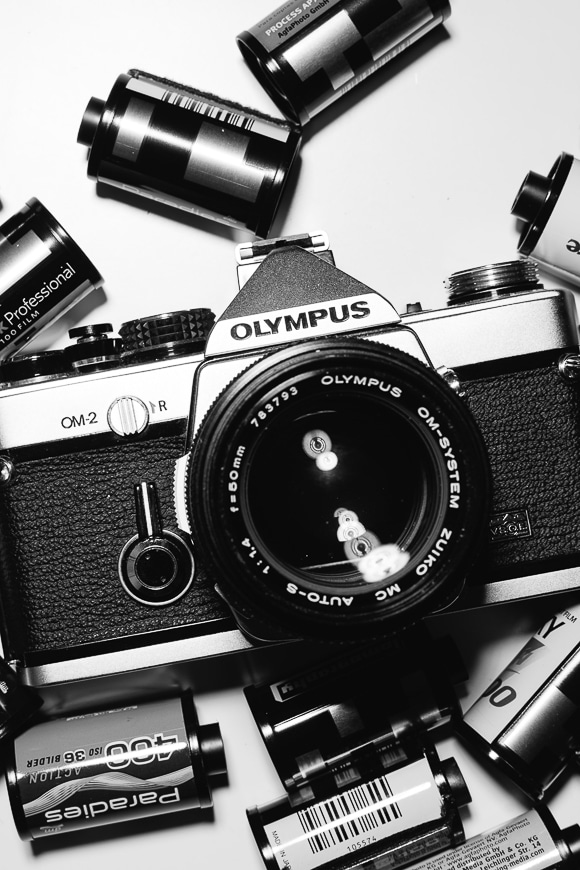
Film cameras are readily available to purchase from most camera stores.
You don’t have to scour second-hand stores or hipster backstreet kiosks to pick up a film camera. For those new to film photography, here are four film cameras to get you started:
- Ilford Sprite 35-II – It’s a plastic-fantastic film camera with a fixed 39mm focal range delivering a 70-degree field of view and an f/9 aperture. The sprite takes 35mm film and features a built-in flash requiring a single AAA battery. It’s a great little light and compact film camera – I picked up one of these to play with film photography.
- Lomography La Sardina 8Ball Camera – The folks at Lomography don’t only create brilliant film stock. Lomography also produces a range of 35mm, 120 and instant cameras fit for beginners. The La Sardina 8Ball Camera resembles a black sardine can and takes a 35mm film. The little film camera features a 22mm wide-angle delivering an 89-degree field of view. The La Sardina has a few extra tricks up its sleeve, including multiple and long exposures, a tripod mounting screw and a flash contact point.
- Lomography Diana F+ Medium Format Camera – If you want to play around with medium format 120 roll film, the Lomography Diana F+ is an ideal film camera. It features a removable 75mm lens with three aperture settings ( f8, f11, and f16) and the ability to use the camera for pinhole photography. The Diana F+ is bundled with a flash and allows for multishop modes, long exposures with a bulb mode and an endless panorama mode.
- Ilford HP5 Plus Single Use Camera – If you want a super simple film camera experience, grab a disposable camera for your very first film photography shoot. Disposable or single-use cameras are available in convenience stores and supermarkets and are a popular inclusion to every table at a wedding.
See our guide to the best 35mm film cameras for some more great options, and learn if you should get your film developed at discount chains like Walmart or Walgreens.
Motion Picture Film Stock (Camera Films)
In this guide we’ve stuck to discussing film stocks for photography, but did you know there’s also motion picture film stock too?
For filmmakers who want to bring a notstalgic/vintage vibe to their movies, Kodak stocks various motion picture film negative reels for you to choose from – Vision3 500T Color Negative Film is a popular one which uses advanced Dye Layering Technology to reduce grain in shadows, to help you push your dynamic range further.
Skin tones also look great with Vision3. It’s a great way to get that film emulsion straight out of your video camera.
Film Stock FAQs

What is film stock made of?
Filmstock is a sheet or strip of transparent plastic film. On one side, a gelatin emulsion with tiny light-sensitive silver halide crystals coats the surface. The emulsion determines the films sensitivity, contrast and image quality.
What is the most common film stock?
The most common film stock is the colour 35mm negative film processed using the C41 method.
C41 film is available at camera stores and supermarkets. Two of the most commonly used C-41 films are Kodak Gold 200 and Fujifilm FujiColour 200. But other than this, there are plenty more of popular film types depending on what you are shooting.
What is a fast film?
The fast film is film stock that’s super sensitive to available light. A fast film detects the details to create an image in low light conditions and is defined by an ISO number. An example of a fast film is Ilford Delta 3200 slide film.
Does Kodak still sell film?
Kodak started creating film stock in the 1880s and continues to produce film today.
Despite a downturn in production during the early years of digital cameras, Kodak’s output has increased in recent years. Their growth is due to the increased popularity of film photography. They produce film for cameras both for recreational and professional use.
How long does film stock last?
Films have an expiry date that’s two years after the manufacture date.
The date guides when the manufacturer can guarantee the film will still produce images. Howver, film lasts a lot longer, and expired film is popular due to the unexpected outcomes it delivers.
It’s always wise to keep any film stock in the refrigerator.
What happens when a film is exposed to light?
A film is light sensitive and designed to capture incoming light thanks to a silver halide gelatin emulsion.
If you expose the whole roll of film to light, it can’t be recovered or used, and any images will be lost.
If you accidentally open the camera’s film door, you will lose around five frames – shut the door and keep shooting.
Final Words

Film photography is an exciting and challenging genre – but the learning experience and rewards are a welcome payoff.
I first learnt photography on film cameras and attended an art school where I processed, developed and printed photos in the school’s lab. It was well before digital cameras and scanners were available.
My friend and I even set up a darkroom in his parent’s ensuite bathroom – along with a homebrew beer operation. I have only just gotten back into film photography after a long absence.
The best bit about film photography is that you can choose how involved you want to become with the process.
Start with just a disposable camera processed at the local supermarket and then move up to a 35mm film camera. Before you know it, you’ll be shooting medium format 120 slide colour reversal film and scouring online marketplaces for a film scanner of your own.
The essential part of film photography is that you have complete creative control of the process.
It’s also a great way to learn about exposure, composition and slowing down to enjoy the creative experience.
What are your thoughts on film photography? Care to share your experiences with the genre?
Please share your comments and questions below to become part of the conversation. Happy shooting.

Check out these 8 essential tools to help you succeed as a professional photographer.
Includes limited-time discounts.






